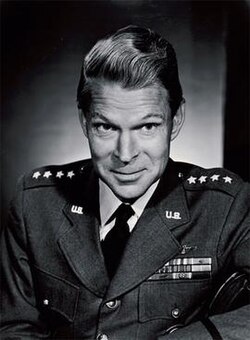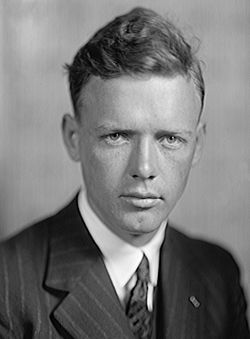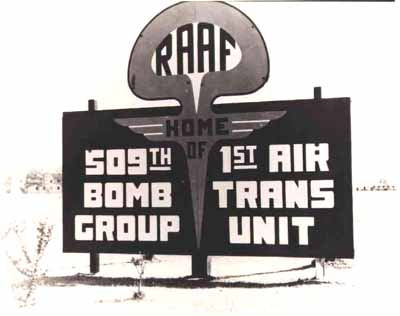“Shortly after I finished recounting the previous interview with Airl to the stenographer, I was summoned urgently to the office of the Commanding Officer of the base. I was escorted by four heavily armed military policemen. When I arrived, I was asked to be seated in a very large, make-shift office that had been arranged with a conference table and chairs. In the office were several dignitaries I had seen at various times in “the gallery”. I recognized a few of them because they were famous men.
I was introduced to these men, which included:
Army Air Force Secretary Symington, [i] (Footnote) General Nathan Twining,
[ii] (Footnote) General Jimmy Doolittle , [iii] (Footnote) General Vandenberg, [iv] (Footnote) and General Norstad. [v] (Footnote)
Much to my surprise Charles Lindbergh [vi] (Footnote) was also in the office. Secretary Symington explained to me that Mr. Lindberg was there as a consultant to the chief of staff of the U.S. Air Force. There were several other men present in the room who were not introduced. I assume these men were personal aides to the officers or agents of some intelligence service.
All of this sudden attention, not only from the Secretary and generals, but from such world famous people as Mr. Lindbergh, and General Doolittle, made me realize how critically important my role as an “interpreter” for Airl was, as seen through the eyes of others. Until this time I was not really aware of this except in an peripheral sense. I suppose this was because I was so absorbed in details of the extraordinary situation. Suddenly, I began to grasp the magnitude of my role. I think that the presence of these men in that meeting was intended, in part, to impress me with this fact!
The Secretary instructed me not to be nervous. He said that I was not in any trouble. He asked me if I thought the alien would be willing to answer a list of questions they had prepared. He explained that they were very eager to discover many more details about Airl, the flying disc, The Domain, and many other subjects that Airl had disclosed in the interview transcripts. Of course, they were mainly interested in questions relating to the military security and the construction of the flying disc.”
 [i] “…General Symington,”…
[i] “…General Symington,”…
His first positions were chairman of the Surplus Property Board (1945), administrator of the Property Administration (1945–1946) and Assistant Secretary of War for Air (1946–1947). On September 18, 1947, the Office of the Secretary of the Air Force was created and Symington became the first Secretary. Symington once formally requested a report from military sources regarding the possible existence of subterranean super humans.
— Reference: Wikipedia.org
 [ii] “…General Nathan Twining, …”
[ii] “…General Nathan Twining, …”
He was named commander of the Air Materiel Command, and in 1947 he took over Alaskan Air Command. In 1947, Twining was asked to study UFO reports; he recommended that a formal study of the phenomenon take place; Project Sign was the result. When Hoyt Vandenberg retired in mid-1953, Twining was selected as chief; during his tenure, massive retaliation based on airpower became the national strategy. In 1957, President Eisenhower appointed Twining chairman of the Joint Chiefs.
— Reference: Wikipedia.org
 [iii] “… General Jimmy Doolittle, …”
[iii] “… General Jimmy Doolittle, …”
“Soon after the attack on Pearl Harbor and the US entry into World War II, Doolittle was promoted to Lieutenant Colonel on January 2, 1942, and went to Headquarters Army Air Force to plan the first aerial raid on the Japanese homeland. He volunteered and received Gen. H.H. Arnold’s approval to lead the attack of 16 B-25 medium bombers from the aircraft carrier USS Hornet, with targets in Tokyo, Kobe, Osaka, and Nagoya. It was the first and only combat mission of his military career.
Doolittle received the Medal of Honor, presented by President Franklin D. Roosevelt at the White House, for planning and leading the successful operation. The Doolittle Raid is viewed by historians as a major public-relations victory for the United States. Although the amount of damage done to Japanese war industry was minor, the raid showed the Japanese their homeland was not invulnerable.
Doolittle was portrayed by Spencer Tracy in the 1944 film Thirty Seconds Over Tokyo and by Alec Baldwin in the 2001 film Pearl Harbor, in which the Doolittle raid was depicted.
On May 10, 1946, Doolittle reverted to inactive reserve status and returned to Shell Oil as a vice president, and later as a director. He was the highest-ranking reserve officer to serve in the U.S. military in World War II.”
EDITOR —
In March 1951, he was appointed a special assistant to the Air Force chief of staff, serving as a civilian in scientific matters which led to Air Force ballistic missile and space programs. (?!)
“He retired from Air Force duty on February 28, 1959 but continued to serve his country as Chairman of the Board of Space Technology Laboratories.”
— Reference: Wikipedia.org
 [iv] “…General Vandenberg…”
[iv] “…General Vandenberg…”
Lieutenant General Vandenberg was designated vice chief of staff of the Air Force on October 1, 1947, and promoted to the rank of General.
— Reference: Wikipedia.org
 [v] “… General Norstad…”
[v] “… General Norstad…”
“On October 1, 1947, following the division of the War Department into the Departments of The Army and The Air Force, General Norstad was appointed deputy chief of staff for operations of the Air Force.”
— Reference: Wikipedia.org
 [vi] “… Charles Lindbergh was also in the office…”
[vi] “… Charles Lindbergh was also in the office…”
“Charles Lindbergh gained sudden great international fame as the first pilot to fly solo across the Atlantic Ocean. He flew from Roosevelt Airfield in Garden City, New York, to Paris (Le Bourget Airport) on 20 May – 21 May 1927 in 33.5 hours. His plane was the single-engine aircraft, The Spirit of St. Louis.
Lindbergh’s accomplishment won him the Orteig Prize; more significant than the prize money was the acclaim that resulted from his daring flight. A ticker-tape parade was held for him down 5th Avenue in New York City on 13 June 1927.
His public stature following this flight was such that he became an important voice on behalf of aviation activities, including the central committee of the National Advisory Committee for Aeronautics in the United States. The massive publicity surrounding him and his flight boosted the aircraft industry and made a skeptical public take air travel seriously. Lindbergh is recognized in aviation for demonstrating and charting polar air-routes, high altitude flying techniques, and increasing aircraft flying range by decreasing fuel consumption. These innovations are the basis of modern intercontinental air travel.
In his six months during WW II in the Pacific in 1944, Lindbergh took part in fighter bomber raids on Japanese positions, flying about 50 combat missions (as a civilian). The U.S. Marine and Army Air Force pilots who served with Lindbergh admired and respected him, praising his courage and defending his patriotism.
After World War II he lived quietly in Connecticut as a consultant both to the chief of staff of the U.S. Air Force and to Pan American World Airways. His 1953 book The Spirit of St. Louis, recounting his non-stop transatlantic flight, won the Pulitzer Prize in 1954.
Dwight D. Eisenhower restored Lindbergh’s assignment with the Army Air Corps and made him a Brigadier General in 1954. In that year, he served on the Congressional advisory panel set up to establish the site of the United States Air Force Academy. In December 1968, he visited the crew of Apollo 8 on the eve of the first manned spaceflight to leave earth orbit.
From the 1960s on, Lindbergh became an advocate for the conservation of the natural world, campaigning to protect endangered species like humpback and blue whales, was instrumental in establishing protections for the “primitive” Filipino group the Tasaday and African tribes, and supporting the establishment of a national park. While studying the native flora and fauna of the Philippines, he also became involved in an effort to protect the Philippine eagle.
In his final years, Lindbergh became troubled that the world was out of balance with its natural environment; he stressed the need to regain that balance, and spoke against the introduction of supersonic airliners.
Lindbergh’s speeches and writings later in life emphasized his love of both technology and nature, and a lifelong belief that “all the achievements of mankind have value only to the extent that they preserve and improve the quality of life.”
In a 1967 Life magazine article, he said, “The human future depends on our ability to combine the knowledge of science with the wisdom of wildness.”
— Reference: Wikipedia.org
Originally posted 2011-04-15 16:02:01. Republished by Blog Post Promoter


